The Menin Gate Memorial, Ypres, Belgium
The Memorial
The Menin Gate Memorial to the Missing is one of four British and Commonwealth memorials to the missing in the battlefield area of the Ypres Salient in Belgian Flanders. The memorial bears the names of 54,389 officers and men from United Kingdom and Commonwealth Forces (except New Zealand and Newfoundland) who fell in the Ypres Salient before 16 August 1917 and who have no known grave.
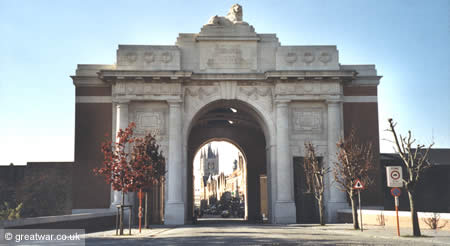
|
The names are engraved in Portland Stone panels fixed to the inner walls of the central Hall of Memory, to the sides of the staircases leading from the lower level to the upper exterior level, and on the walls inside the loggias on the north and south sides of the building.
The photograph is taken looking westwards into the city centre of Ypres (now known by its Flemish name of Ieper). The belfry of the famous Cloth Hall (the Lakenhalle) on the market place (Grote Markt) is visible through the memorial's archway.
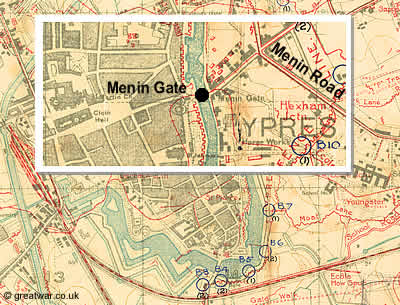
|
The road leading from the market place to the Menin Gate Memorial is the Meensestraat. This road continues through the Menin Gate Memorial and becomes the Marshalk Frenchlaan. This road is named after Field Marshal Sir John French, who was appointed to the title of 1st Earl of Ypres after the war. He was the first commander of the British Expeditionary Force (B.E.F.) from the time when it landed in France in August 1914 to December 1915. After approximately 150 metres there is a crossroads and, taking the right turn, the road becomes the Meenseweg: the road to Menen. In 1914 Menen was known by its French name of Menin. This road became known to the British Army as “the Menin Road”.
Why here?
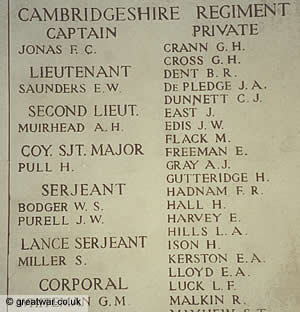
|
From October 1914 British and Commonwealth troops began to march east through the town's eastern exit or gateway, known at the time by its French name of the Porte de Menin. This translates as the Menin Gate. In its Flemish translation, as it is now known, the gateway is called the Menenpoort. In 1914 there was no building or formal gate as such, it was simply a crossing point over the moat and through the ramparts of the old town fortifications.
Leaving the city of Ypres the troops marched through this location onto the roads leading eastwards into the battlefields of the Ypres Salient. Many of them would make their way along the road to Menin, which soon became known to the soldiers as “the Menin Road”.
For the next four years of the Great War soldiers from practically every British and Commonwealth regiment passed over this spot. Many thousands of them never returned.
The Missing of the Ypres Salient
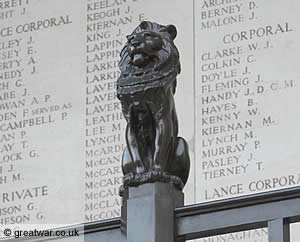
|
Thousands of soldiers in the British Army and Commonwealth Forces lost their lives fighting in the Ypres Salient. The remains of over 90,000 of them have never been found or identified. They are, therefore, buried somewhere in the Ypres Salient with no known grave.
The site of the The Menin Gate Memorial was considered to be a fitting location to place a memorial to commemorate the missing British and Commonwealth soldiers.
Design of the Menin Gate Memorial
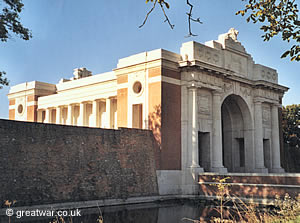
|
The Menin Gate Memorial to the Missing was designed by Sir Reginald Blomfield. He was one of four Principle Architects engaged in directing the construction of over 1,200 British and Commonwealth cemeteries and memorials along the Western Front for the Imperial War Graves Commission (now named the Commonwealth War Graves Commission). Sculptures on the memorial were by Sir William Reid-Dick.
The memorial is built of reinforced concrete faced with Euville stone and red brick. The single span Hall of Memory (36.5 metres long and 20 metres wide) is covered in by a coffered half-elliptical arch.
Hall of Memory
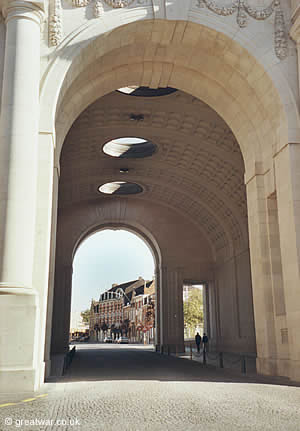
|
At both ends of the Hall of Memory there is an archway (9 metres wide and 14.5 metres high). There are two flat arches on either side of it (3.5 metres wide and nearly 7 metres high). Each of the flat arches is flanked on either side by an engaged Doric column and surmounted by an entablature.
Over each of the two centre arches there is a large panel for a dedicatory inscription. The same inscription is carved on each of the western and eastern panels:
TO THE ARMIES
OF THE BRITISH EMPIRE
WHO STOOD HERE
FROM 1914 TO 1918
AND TO THOSE OF THEIR DEAD
WHO HAVE NO KNOWN GRAVE
Western Entrance to the Memorial
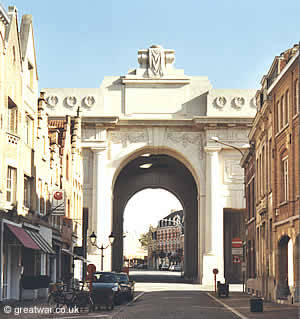
|
Above the panel with the dedicatory inscription on the western entrance, facing the town, there is a sculpted sarcophagus with a flag and a wreath.
For four years, between October 1914 and September 1918 thousands of British troops marched up this street, now called Meensestraat. They passed through this location as the old town gateway on the road to Menin, now the location of the arch of the memorial, and went out into the Ypres Salient battlefields.
Eastern Entrance to the Memorial
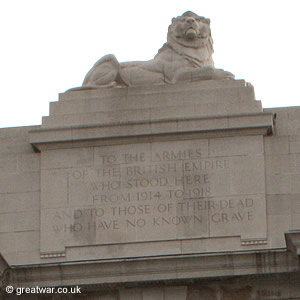
|
Above the panel on the east side of the memorial there is a sculpture of a lion lying down. He is looking away from the city and facing the Ypres Salient battlefields.
The lion feature was included to mark the fact that at the start of the war in 1914 the Menenpoort or the Porte de Menin (the Menin Gate in its Flemish and French names) was guarded by two stone sculptured lions, one on either side of the gateway. For more about the two original lions see our Related Topic below for the History of the Menin Gate.
Figures of small lions also feature sitting on the balustrades of the loggias at the northern and southern sides of the memorial.
North and South Staircases
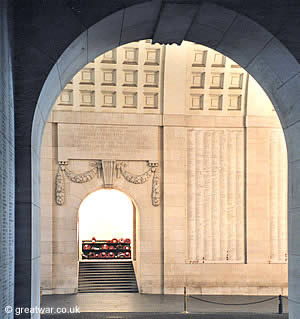
|
In the centre of both the north and the south side of the Menin Gate there is a broad staircase leading from the Hall of Memory up to the ramparts and the loggias.
The inscription over the entrances to the staircases reads:
AD MAJOREM DEI GLORIAM
HERE ARE RECORDED NAMES
OF OFFICERS AND MEN WHO FELL
IN YPRES SALIENT BUT TO WHOM
THE FORTUNE OF WAR DENIED
THE KNOWN AND HONOURED BURIAL
GIVEN TO THEIR COMRADES
IN DEATH
Each of the two stairways leads to the right and left and on up to the loggias on the upper outside level of the building. The panels of names continue on each side of the stairways.
Loggias on the Ramparts
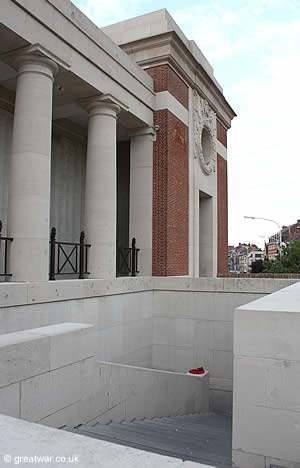
|
A feature of the architecture on this building is that two loggias run along the length of the north and south sides of the memorial on the upper level. A loggia is a gallery or a corridor open to the air on one side and supported by columns.
This upper level is situated on the ramparts of the old fortifications dating back to the time when the city was protected by fortified walls and a moat.
The inscribed panels of Portland Stone, bearing the names of the missing casualties, continue up the walls of the north and south stairways and then along the walls of the upper level of the memorial. The loggia on the opposite side of the memorial is the same.
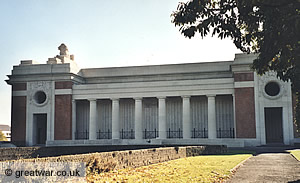
|
In the photograph of the side view of the northern loggia the stone lion can be seen. He lies on the eastern end of the Menin Gate Memorial looking out to the east across the Ypres Salient battlefields, where so many lives were lost.
The Inscribed Names
The names are inscribed on the memorial in blocks by regiment. The register of names and the Panel Number where a casualty can be found are located in the brass box just inside the western entrance of the memorial. Registers are arranged alphabetically by name.
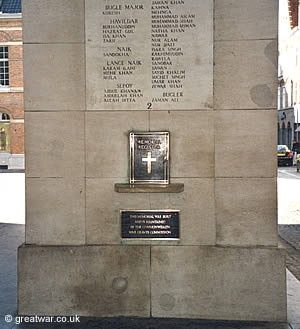
|
Odd numbered panels 1-59 are to be found on the north side of the road. All even numbered panels 2-60 will be found on the south side of the road.
Each panel on the memorial contains the names of several hundred casualties, arranged in order of seniority of rank and alphabetically by name.
Search for Names on the Menin Gate Memorial
To search online for the alphabetical list of names recorded on the Menin Gate Memorial and to find out more about the memorial you can go to the Menin Gate Memorial page on the Commonwealth War Graves Commission website:
Website: www.cwgc.org (Ypres) Menin Gate Memorial
“General Officer Commanding Menin Gate”
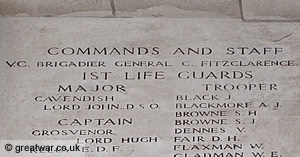
|
The most senior casualty named on the Menin Gate Memorial is that of Brigadier General Charles Fitzclarence, VC. He was killed whilst commanding the 1st Guards Brigade during the First Battle of Ypres in the autumn of 1914. His date of death was 12 November 1914. Almost exactly fifteen years before he met his death in the Ypres Salient, Charles Fitzclarence was serving as a Captain in the Boer War and was awarded the Victoria Cross for three actions of gallantry in October and December 1899.
Brigadier General Fitzclarence played a key role in directing the successful action to recapture the village of Gheluvelt from the German Army with a British counter-attack on 31 October 1914. After his death on 12 November his body was never found. He was aged 49 when he died. A farm in the vicinity of the place where he was killed was named Fitzclarence Farm on British Army trench maps.
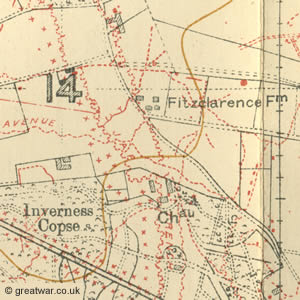
|
As the most senior officer named on the Menin Gate Memorial, he became known to WW1 Veterans as “GOC (General Officer Commanding) Menin Gate”. His name can be found as the first name at the very top of Panel 3, which is the first panel on the left when entering the memorial from its western end (from the direction of the town and Meensestraat).
Location of the Menin Gate Memorial
The Menin Gate Memorial to the Missing is located on the east side of the town of Ypres.
Access to the Menin Gate
During the two year restoration works access to the memorial and name panels will be restricted.
Access to the Memorial is easiest on foot. There is parking in nearby streets or in the Grote Markt (market square), which is a few minutes' walk away.
Great care should be taken when crossing the road which runs through the arch of the Memorial. This is a busy main road into the town centre. The road is only closed to traffic during the daily Last Post ceremony at 20.00 hours and on special occasions.
Related Topics
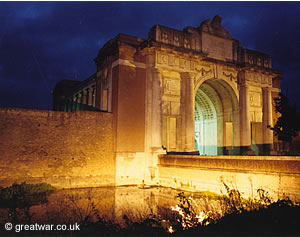
|
The Menin Gate Before 1914
For information about the Menin Gate before and during the war see our page:
History of the Menin GateOpening Ceremony at the Menin Gate, 1927
For information on the Menin Gate opening ceremony in July 1927 see:
The Menin Gate Inauguration CeremonyLast Post at the Menin Gate Memorial
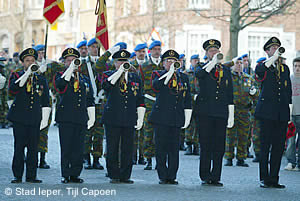
|
Every evening at 8 o'clock (20.00 hours) Last Post is played at the Menin Gate Memorial. This was started in 1927 and it has been played almost every night since except for a period in the Second World War when Ypres was occupied by German Forces.
To find out more about the ceremony and to hear a live recording of the Last Post and Réveille played at the Menin Gate go to:
Last Post at the Menin Gate Memorial
Menin Gate Memorial Bronze Replica
A bronze scale model of the Memorial is located on the south side of the ramparts.
Menin Gate Memorial Bronze Replica
Ypres Salient Memorials to the Missing
The names of the missing casualties of United Kingdom, Commonwealth and New Zealand forces who died in the Ypres Salient from the date of 16 August 1917 are named on the Memorial to the Missing at Tyne Cot. The names of the missing of New Zealand are inscribed on two other memorials at Buttes New British Cemetery and Messines Ridge British Cemetery.
These memorials are listed with map locations at:
Monuments and Memorials on the Ypres Salient
Battles of the Ypres Salient
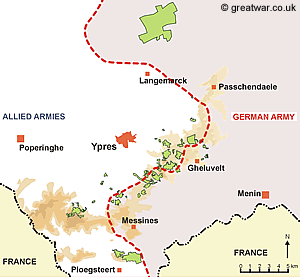
|
Find out about the major battles which took place near Ypres over the four years of the war.
Ypres - Ieper
The city of Ypres (now known by its Flemish name of Ieper) offers all sorts of facilities and places of interest for visitors to the First World War battlfields, such as tourist information, museums, places to eat, places to stay, shops and sites of special interest relating to the 1914-1918 war. Go to:
Ypres - IeperCommonwealth War Graves Commission
The Commonwealth War Graves Commission (CWGC) is the agency responsible for the maintenance and care of the official memorials and military cemeteries for casualties of United Kingdom and Commonwealth Forces. The CWGC has an online register of United Kingdom and Commonwealth Forces casualties who died in all conflicts from 1914-1918. The register is called the “Debt of Honour” and can be searched to find the location of a grave or memorial. For more information about the CWGC and the information you can find about a casualty go the CWGC website:
Website: www.cwgc.org
Further Reading

Before Endeavours Fade
by Rose E B Coombs
The first modern guidebook to the Western Front battlefields, first published in 1976, by the late Rose E B Coombs. Regularly updated this is a highly recommended guidebook for the first time visitor. Using illustrated Michelin maps the guidebook takes the visitor on routes through the major battlefields from the Belgian coast to Verdun, passing all the important sites and including many of the not so well known landmarks and battle monuments.

Major and Mrs.Holt's Battlefield Guide to Ypres Salient (Major & Mrs Holt's Battlefield Guide) (Paperback)
by Tonie Holt and Valmai Holt
Published by Pen & Sword Books Ltd. Pap/Map edition (14 Feb 1997); 272 pages. ISBN-10: 0850525519 & ISBN-13: 978-0850525519

Ypres in War and Peace
by Martin Marix Evans
Published by Pitkin Guides, English edition (June 1992); ISBN-10: 0853726108 & ISBN-13: 978-0853726104
Acknowledgements
(1) British Army Trench Map 28 N.W.4. dated 13-07-18.
(2) Photograph courtesy of the Ieper Tourist Office, copyright Stad Ieper: Tijl Capoen.
References to the memorial details by kind permission of the Commonwealth War Graves Commission. To find out more about the work of the Commission visit the website:
Website: www.cwgc.org


